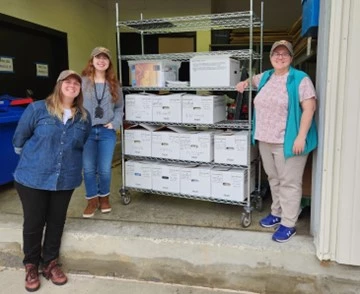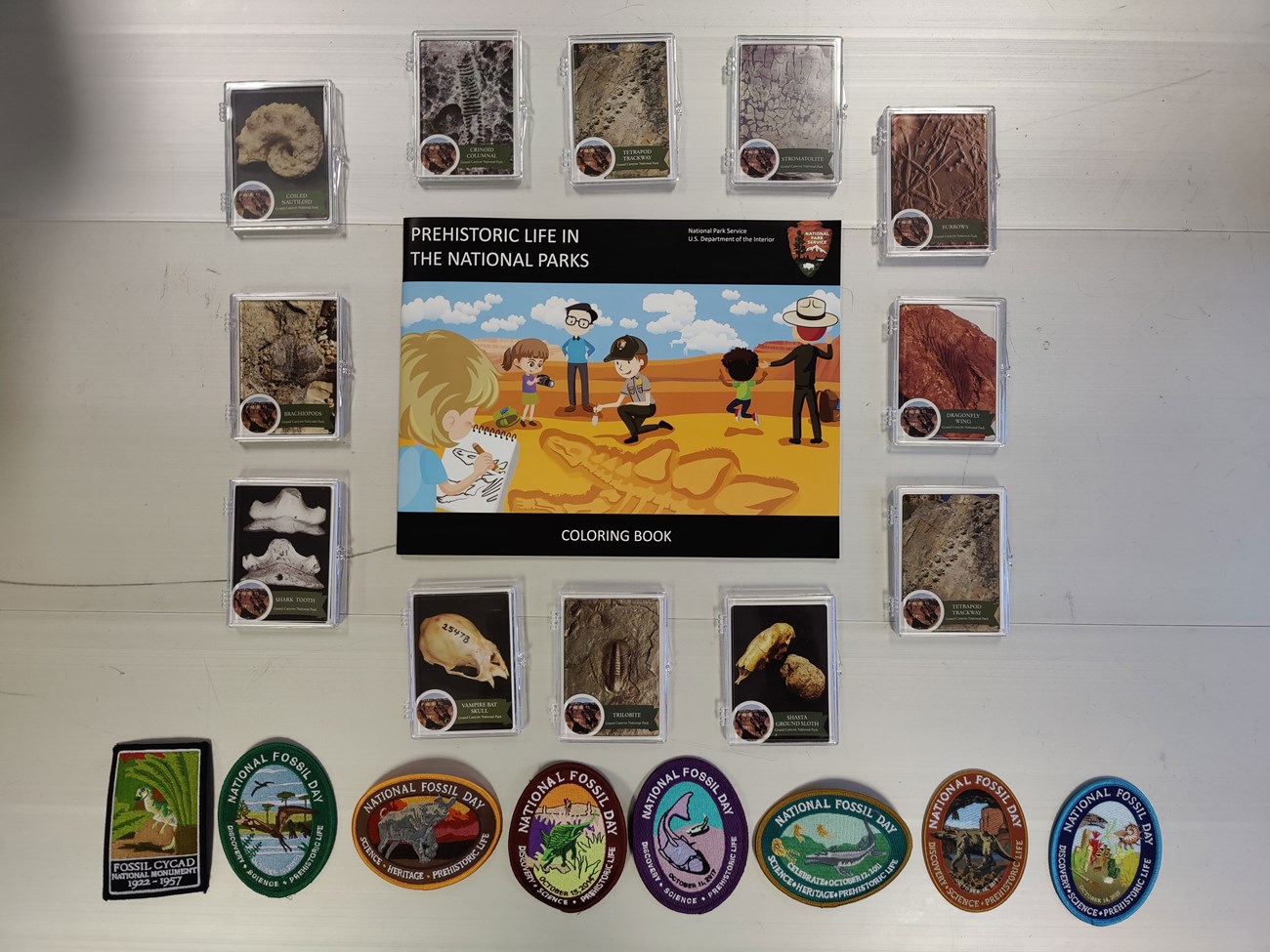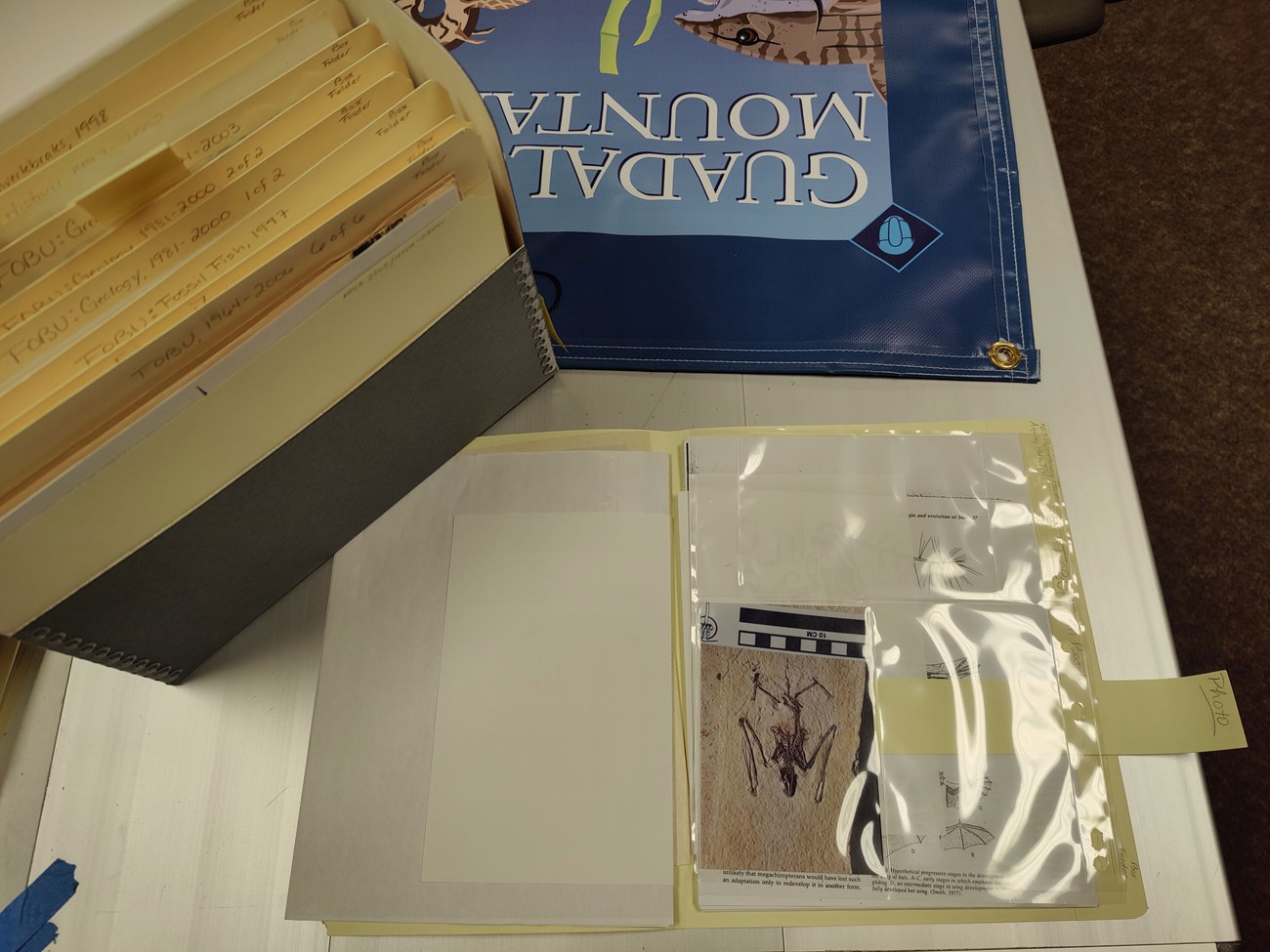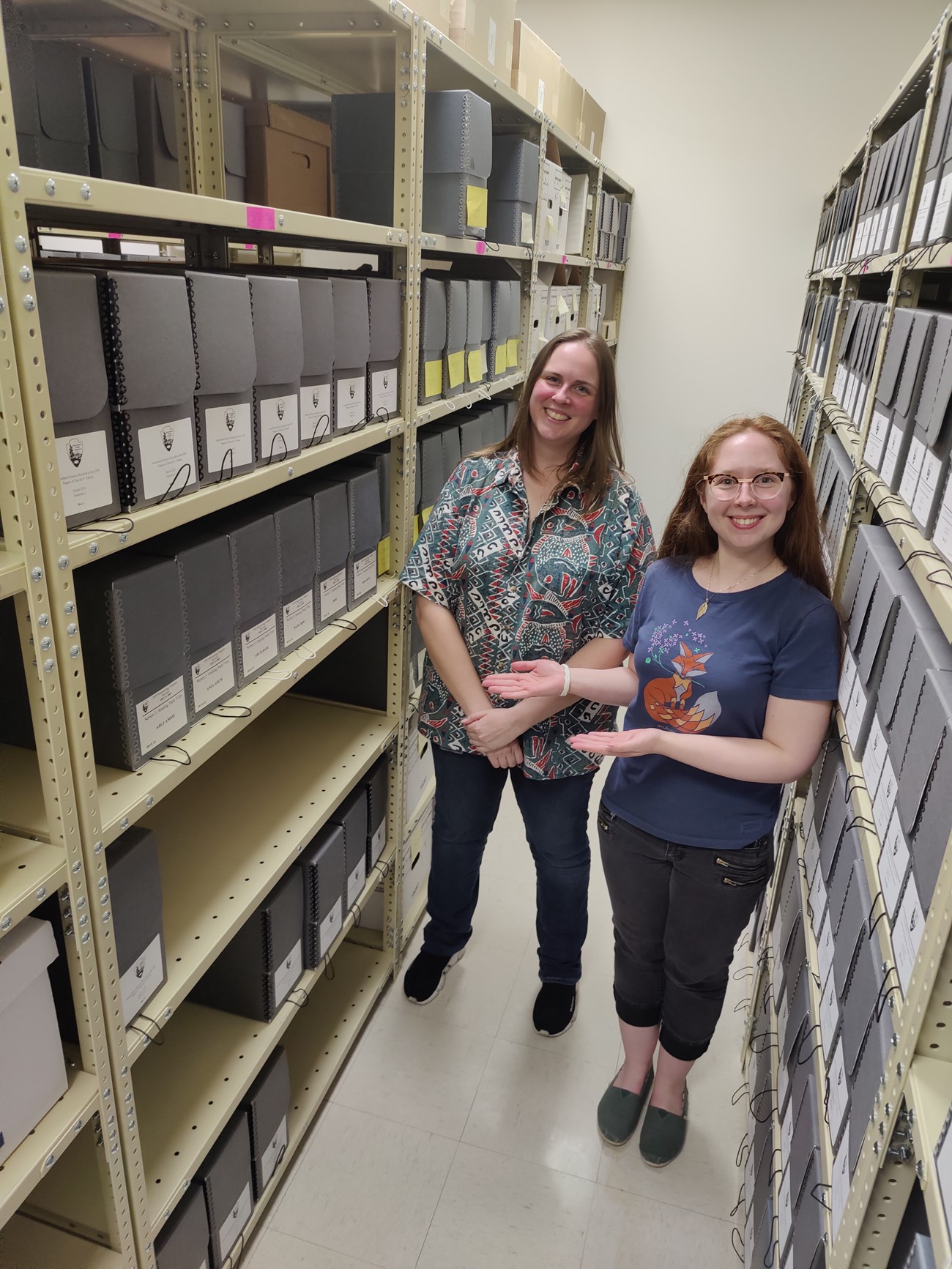Part of a series of articles titled Park Paleontology News - Vol. 16, No. 1, Spring 2024.
Article
Preserving the NPS Fossil Record: The NPS Paleontology Program Archiving Project

Article by Molly Williams and Emma Squire, Archivists
National Council for Preservation Education / NPS Harpers Ferry Center
for Park Paleontology Newsletter, Spring 2024

NPS photo.
What are the NPS Paleontology Records?
Vincent Santucci, NPS Senior Paleontologist, recalls that a speaker at the first Federal Paleontology Conference proudly announced that 12 parks had paleontological resources. This statement inadvertently revealed that park staffs were largely unaware that they had these resources. Thus began the accumulation of records as Vince began reaching out to parks and colleagues, conducting literature reviews, and visiting other repositories to determine the true number of NPS sites with paleontological resources. Vince developed and grew a collection of supporters who helpfully aided in the search. The result of this 40-year quest is the NPS Paleontology Program Records.
The NPS Paleontology Program Records preserve the history of NPS paleontology resources for present and future use, including resource management, research, and education. The collection contains park-specific files, service-wide records, correspondence, publications, Geological Resource Inventories (GRIs), Inventory and Monitoring reports (I&Ms), photographs and negatives, maps, oral histories, and documentation of Junior Ranger and National Fossil Day programs. These are a mix of analog and born-digital records. The NPS History Collection also includes museum objects from National Fossil Day events. This “swag” consists of pins, patches, coins, and more. In 2023, Vincent initiated a project to have this collection of material formally archived with the NPS History Collection at Harpers Ferry Center.

NPS photo.
What is an archive?
An archive is a repository that stores collections in a controlled environmental to preserve them for present and future use by the public. The archives—the records themselves—consist of more than just documents! Often, there is a mix of textual records, audiovisual media (photographs, film-based materials, magnetic media, etc.), maps, plans and drawings, and increasingly, digital records. Archives categorize these materials as either analog or digital. Analog are the more traditionally thought-of materials that can be found in archives, such as paper documents and photos. Born-digital materials are electronically created materials (think Word documents, emails, spreadsheets, etc.). It’s important to note that in the digital world, when individuals “archive their data” this is not the same definition as an “archive” or “archives”.

Who’s involved: Team Paleo!
Archiving the NPS Paleontology Program Records has been a team effort. Vince and NPS History Collection Archivist Nancy Russell put their heads together a couple of years ago and came up with the project to archive and share the decades of research, correspondence, and other materials documenting NPS fossils, fossil management, and the work of the program. Through the $35,000 of funding provided by the NPS Geological Resources Division, this project has been able to finally come to fruition. Vince and Nancy oversee the project, but the hands-on work has been done by National Center for Preservation Education (NCPE) interns Emma Squire and Molly Williams. Justin Tweet, paleontologist with the NPS Paleontology Program, provided technical advice as well as the important perspective of an end-user for the collection.
Processing, scanning, and archiving
Molly and Emma began to work on the collection in September 2023. The first step, as with any new collection, is to evaluate it. An archivist needs to get “the lay of the land” through gaining an understanding of the types of materials in the collection (paper, photographs, audiovisual materials, etc.), their organization, and their provenance—the origin of the collection—before creating a working processing plan. This plan helps archivists broadly understand the categories (called series/subseries) that make up the collection and is drafted following an initial survey with the donor(s) where key questions are asked. In our case, we are fortunate to be able to actively work with Vince and Justin and have been able to ask questions throughout the project.
The term processing refers to arranging, rehousing, and describing an archival collection. This involves refoldering and organizing the documents using appropriately sized archival materials (i.e., pH neutral and lignin free materials). Metal fastenings such as binder clips, rusting staples, paper clips, and other materials can cause preservation issues in the future, so they are removed. Documents that need conservation treatment (e.g., those with tape or glue residues, tears, or other condition issues) and materials that need to be separated are flagged. Examples of what would be separated are oversized maps or drawings—which are stored in large flat file drawers—and photographic materials made from cellulose acetate, color prints and negatives that will be kept in cold storage for long-term preservation. When materials are separated, separation sheets are created to document where they came from in order to maintain their context. Additionally, we cull any unnecessary duplicates. As the folders are arranged in boxes, a container list is created. The container list simply provides information such as the title and date range of the folders in each box.
The physical collection currently measures 55 linear feet! A linear foot is a measurement that archivists use to determine how much shelf space the archived material uses as opposed to counting every individual document or pages. This calculation does not include the tens of thousands of born-digital files that have yet to be received. While some of the materials in this collection may exist in other repositories, such as a map created by the USGS or a program from a conference, it’s the context within the NPS Paleontology Program records that gives it meaning and value for NPS resource management.

Scanning for use
Archivists don’t usually scan collections as part of processing; however, this project was set up to do just that. Digitizing the park-specific files was an important aspect of this project in order to give the NPS Paleontology staff continued access to these records. Some of the park-specific records were scanned by Vince, with Molly and Emma finishing the work. While the use of two scanners allowed the process to be expedited, digitization has been quite the undertaking! In total, nearly 5,700 records have been scanned and will be added to the 190,000+ files in the NPS Paleontology digital archive to create a seamless resource for ongoing paleontology research and resource management.
Scanning is not the final step, however. Just as with the analog records, the digital files need to be organized into folders and the files themselves need to be named. Through the use of a bulk file renaming utility software, we can ensure that the files are consistent with the file naming convention, a schema that we created with Justin and Vince. File names need to meet archival standards in terms of formatting, the type of characters used, character lengths, and other characteristics. At the same time, it should be useful and understandable for Vince and Justin as these files will continue to be actively used by them. Nancy described file naming as “more of an art than a science. Two people can conceivably come up with different file names even when correctly implementing the naming conventions”. Once the files are named, the scans will also be provided to the National Archives and Records Administration (NARA) as a record copy. The end goal is to have all of the born-digital files, including those on the NPS Paleontology server, renamed according to the schema.
Uncovering hidden gems
One of the best parts about processing is that you never know what you will find. Each box brings the opportunity to uncover something new. Here are a few of the “gems” we’ve found.
The initial correspondence sent to parks inquiring about the number and status of paleontological resources are iconic documents. This correspondence is where it all began. Often, park staff replied that they had little to no information regarding paleontological resources, but the question sparked an interest to find out more, to dig deeper in the park’s own archives. As more and more parks are confirmed to have paleontological resources, the excitement felt by everyone involved is palpable in the records.
The NPS Paleontology Program records contain oral history interviews of paleontologists and other park staff, scientists, university professors, and other key players in NPS paleontology. We enjoyed the opportunity to review the transcripts, listen to the audio, and, in a sense, get to “know” these individuals as more than just names on publications and correspondence that we come across in folders. It truly is a privilege to hear individuals recount their personal experiences and perspectives in their own voices.
While one might initially expect that the paleontology records are only scientific publications, the NPS Paleontology Program actually has a robust education program for people of all ages, including the Junior Paleontologist Program, National Fossil Day, and even a coloring book. An unexpected find tucked in the Badlands records are submissions from 1985 and 1986 for a titanothere coloring contest. This was a fun activity to engage kids from all over the country who mailed in their artwork. There was a lot of creativity in these submissions, and it was neat to see their visions of what the titanothere’s paleoenvironment looked like!
Emma's favorite fossils are the pygmy mammoths at Channel Islands National Park. The pygmy mammoth is an interesting case study in island adaptations from their larger mainland descendants. The Santa Rosa Island specimen found in 1994 is a nearly complete skeleton, and more recent finds add to the story of the pygmy mammoth's evolution. While it is difficult for Molly to pick just one site, her current favorite is Carlsbad Caverns National Park. The park’s paleontological discoveries, like the musk ox in the aptly named Musk Ox cave, are fascinating. The records also contain the testimonies that played a role in establishing the Lechuguilla Protection Act of 1993, legislation that prevents drilling and other mining activities that could harm the cave resources.

How can you use the archives?
When finished, the finding aid will be posted at NPS History Collection Finding Aids. In the meantime, e-mail us with any questions. We’re always happy to help!
Related Links
Last updated: April 3, 2024
